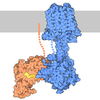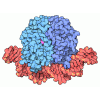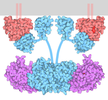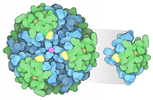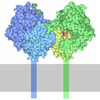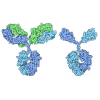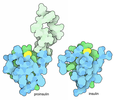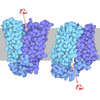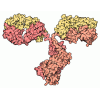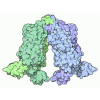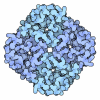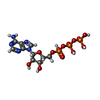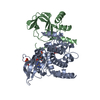+ Open data
Open data
- Basic information
Basic information
| Entry | Database: PDB / ID: 9edc | ||||||
|---|---|---|---|---|---|---|---|
| Title | Reset Type-I Protein Kinase A Holoenzyme | ||||||
 Components Components |
| ||||||
 Keywords Keywords | SIGNALING PROTEIN / Kinase / Regulator | ||||||
| Function / homology |  Function and homology information Function and homology informationPKA-mediated phosphorylation of CREB / PKA-mediated phosphorylation of key metabolic factors / sperm head-tail coupling apparatus / ROBO receptors bind AKAP5 / HDL assembly / PKA activation in glucagon signalling / DARPP-32 events / CREB1 phosphorylation through the activation of Adenylate Cyclase / GPER1 signaling / channel activator activity ...PKA-mediated phosphorylation of CREB / PKA-mediated phosphorylation of key metabolic factors / sperm head-tail coupling apparatus / ROBO receptors bind AKAP5 / HDL assembly / PKA activation in glucagon signalling / DARPP-32 events / CREB1 phosphorylation through the activation of Adenylate Cyclase / GPER1 signaling / channel activator activity / Factors involved in megakaryocyte development and platelet production / Regulation of glycolysis by fructose 2,6-bisphosphate metabolism / mitochondrial protein catabolic process / PKA activation / nucleotide-activated protein kinase complex / cell communication by electrical coupling involved in cardiac conduction / Hedgehog 'off' state / high-density lipoprotein particle assembly / Rap1 signalling / negative regulation of cAMP/PKA signal transduction / cAMP-dependent protein kinase inhibitor activity / cAMP-dependent protein kinase / regulation of protein processing / cAMP-dependent protein kinase activity / sarcomere organization / protein localization to lipid droplet / cAMP-dependent protein kinase complex / regulation of bicellular tight junction assembly / cellular response to parathyroid hormone stimulus / Loss of phosphorylation of MECP2 at T308 / CREB1 phosphorylation through the activation of Adenylate Cyclase / negative regulation of interleukin-2 production / PKA activation / regulation of osteoblast differentiation / cellular response to cold / sperm capacitation / negative regulation of glycolytic process through fructose-6-phosphate / Triglyceride catabolism / ciliary base / High laminar flow shear stress activates signaling by PIEZO1 and PECAM1:CDH5:KDR in endothelial cells / Vasopressin regulates renal water homeostasis via Aquaporins / protein kinase A regulatory subunit binding / negative regulation of activated T cell proliferation / protein kinase A catalytic subunit binding / intracellular potassium ion homeostasis / mesoderm formation / RET signaling / cAMP/PKA signal transduction / Interleukin-3, Interleukin-5 and GM-CSF signaling / immunological synapse / plasma membrane raft / axoneme / PKA activation in glucagon signalling / Regulation of MECP2 expression and activity / DARPP-32 events / regulation of cardiac conduction / regulation of macroautophagy / cardiac muscle cell proliferation / regulation of cardiac muscle contraction / sperm flagellum / postsynaptic modulation of chemical synaptic transmission / regulation of cardiac muscle contraction by regulation of the release of sequestered calcium ion / vascular endothelial cell response to laminar fluid shear stress / renal water homeostasis / cAMP binding / Hedgehog 'off' state / Ion homeostasis / negative regulation of TORC1 signaling / regulation of proteasomal protein catabolic process / sperm midpiece / multivesicular body / cellular response to epinephrine stimulus / calcium channel complex / positive regulation of gluconeogenesis / protein serine/threonine/tyrosine kinase activity / Mitochondrial protein degradation / cellular response to glucagon stimulus / Loss of Nlp from mitotic centrosomes / Loss of proteins required for interphase microtubule organization from the centrosome / Recruitment of mitotic centrosome proteins and complexes / acrosomal vesicle / CD209 (DC-SIGN) signaling / positive regulation of calcium-mediated signaling / Recruitment of NuMA to mitotic centrosomes / Anchoring of the basal body to the plasma membrane / regulation of heart rate / FCGR3A-mediated IL10 synthesis / protein export from nucleus / positive regulation of phagocytosis / AURKA Activation by TPX2 / positive regulation of protein export from nucleus / negative regulation of smoothened signaling pathway / neural tube closure / Regulation of insulin secretion / neuromuscular junction / cellular response to glucose stimulus / Degradation of GLI1 by the proteasome / positive regulation of cholesterol biosynthetic process / Degradation of GLI2 by the proteasome / GLI3 is processed to GLI3R by the proteasome Similarity search - Function | ||||||
| Biological species |  Homo sapiens (human) Homo sapiens (human) | ||||||
| Method | ELECTRON MICROSCOPY / single particle reconstruction / cryo EM / Resolution: 4.18 Å | ||||||
 Authors Authors | Venkatakrishnan, V. / Buckley, T. / Laremore, T.N. / Armache, J.P. / Anand, G.S. | ||||||
| Funding support |  United States, 1items United States, 1items
| ||||||
 Citation Citation |  Journal: J Am Chem Soc / Year: 2025 Journal: J Am Chem Soc / Year: 2025Title: Multiplicity of Regulatory Subunit Conformations Defines Structural Ensemble of Reset Protein Kinase A Holoenzyme. Authors: Varun Venkatakrishnan / Tatiana N Laremore / Theresa S C Buckley / Jean-Paul Armache / Ganesh S Anand /  Abstract: How protein kinase A (PKA) is reset to a basal state following 3'5'-cyclic adenosine monophosphate (cAMP)-mediated activation is unknown. Here we describe the mechanism of cAMP-PKA type I signal ...How protein kinase A (PKA) is reset to a basal state following 3'5'-cyclic adenosine monophosphate (cAMP)-mediated activation is unknown. Here we describe the mechanism of cAMP-PKA type I signal termination leading to a reset of PKA by holoenzyme formation through the obligatory action of phosphodiesterases (PDEs). We report a catalytic subunit (Cα)-assisted mechanism for the reset of type I PKA and describe for the first time multiple structures of the reset PKA holoenzyme (RIα:Cα) that capture an ensemble of multiple conformational end-states through integrative electron microscopy and structural mass spectrometry approaches. Together these complementary methods highlight the large conformational dynamics of the regulatory subunit (RIα) within the tetrameric reset PKA holoenzyme. The cAMP-free reset PKA holoenzyme adopts multiple distinct conformations of RIα with contributions from the N-terminal linker and CNB-B dynamics. Our findings highlight the interplay between RIα, Cα, and PDEs (PDE8) in cAMP-PKA signalosomes to offer a new paradigm for PDE-mediated regulation of cAMP-PKA signaling. | ||||||
| History |
|
- Structure visualization
Structure visualization
| Structure viewer | Molecule:  Molmil Molmil Jmol/JSmol Jmol/JSmol |
|---|
- Downloads & links
Downloads & links
- Download
Download
| PDBx/mmCIF format |  9edc.cif.gz 9edc.cif.gz | 111.2 KB | Display |  PDBx/mmCIF format PDBx/mmCIF format |
|---|---|---|---|---|
| PDB format |  pdb9edc.ent.gz pdb9edc.ent.gz | 79.6 KB | Display |  PDB format PDB format |
| PDBx/mmJSON format |  9edc.json.gz 9edc.json.gz | Tree view |  PDBx/mmJSON format PDBx/mmJSON format | |
| Others |  Other downloads Other downloads |
-Validation report
| Summary document |  9edc_validation.pdf.gz 9edc_validation.pdf.gz | 1.1 MB | Display |  wwPDB validaton report wwPDB validaton report |
|---|---|---|---|---|
| Full document |  9edc_full_validation.pdf.gz 9edc_full_validation.pdf.gz | 1.1 MB | Display | |
| Data in XML |  9edc_validation.xml.gz 9edc_validation.xml.gz | 24.9 KB | Display | |
| Data in CIF |  9edc_validation.cif.gz 9edc_validation.cif.gz | 34.3 KB | Display | |
| Arichive directory |  https://data.pdbj.org/pub/pdb/validation_reports/ed/9edc https://data.pdbj.org/pub/pdb/validation_reports/ed/9edc ftp://data.pdbj.org/pub/pdb/validation_reports/ed/9edc ftp://data.pdbj.org/pub/pdb/validation_reports/ed/9edc | HTTPS FTP |
-Related structure data
| Related structure data |  47944MC 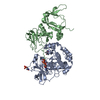 9eddC 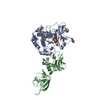 9edeC M: map data used to model this data C: citing same article ( |
|---|---|
| Similar structure data | Similarity search - Function & homology  F&H Search F&H Search |
- Links
Links
- Assembly
Assembly
| Deposited unit | 
|
|---|---|
| 1 |
|
- Components
Components
| #1: Protein | Mass: 40737.297 Da / Num. of mol.: 1 Source method: isolated from a genetically manipulated source Source: (gene. exp.)  Homo sapiens (human) / Gene: PRKACA, PKACA / Production host: Homo sapiens (human) / Gene: PRKACA, PKACA / Production host:  |
|---|---|
| #2: Protein | Mass: 47415.410 Da / Num. of mol.: 1 Source method: isolated from a genetically manipulated source Source: (gene. exp.)   |
| #3: Chemical | ChemComp-ATP / |
| Has ligand of interest | Y |
| Has protein modification | Y |
-Experimental details
-Experiment
| Experiment | Method: ELECTRON MICROSCOPY |
|---|---|
| EM experiment | Aggregation state: PARTICLE / 3D reconstruction method: single particle reconstruction |
- Sample preparation
Sample preparation
| Component | Name: Reset type-I PKA holoenzyme complex of regulatory and catalytic subunits Type: COMPLEX / Entity ID: #1-#2 / Source: RECOMBINANT | ||||||||||||||||||||||||||||||
|---|---|---|---|---|---|---|---|---|---|---|---|---|---|---|---|---|---|---|---|---|---|---|---|---|---|---|---|---|---|---|---|
| Molecular weight | Experimental value: NO | ||||||||||||||||||||||||||||||
| Source (natural) | Organism:  Homo sapiens (human) Homo sapiens (human) | ||||||||||||||||||||||||||||||
| Source (recombinant) | Organism:  | ||||||||||||||||||||||||||||||
| Buffer solution | pH: 7 | ||||||||||||||||||||||||||||||
| Buffer component |
| ||||||||||||||||||||||||||||||
| Specimen | Conc.: 0.6 mg/ml / Embedding applied: NO / Shadowing applied: NO / Staining applied: NO / Vitrification applied: YES | ||||||||||||||||||||||||||||||
| Specimen support | Grid type: Quantifoil R2/1 | ||||||||||||||||||||||||||||||
| Vitrification | Instrument: FEI VITROBOT MARK IV / Cryogen name: ETHANE |
- Electron microscopy imaging
Electron microscopy imaging
| Experimental equipment | 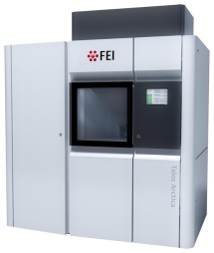 Model: Talos Arctica / Image courtesy: FEI Company |
|---|---|
| Microscopy | Model: FEI TALOS ARCTICA |
| Electron gun | Electron source:  FIELD EMISSION GUN / Accelerating voltage: 200 kV / Illumination mode: SPOT SCAN FIELD EMISSION GUN / Accelerating voltage: 200 kV / Illumination mode: SPOT SCAN |
| Electron lens | Mode: OTHER / Nominal defocus max: 2200 nm / Nominal defocus min: 1000 nm |
| Image recording | Electron dose: 49.66 e/Å2 / Film or detector model: FEI FALCON IV (4k x 4k) / Num. of real images: 4559 |
- Processing
Processing
| EM software |
| ||||||||||||||||||||||||||||||||||||||||
|---|---|---|---|---|---|---|---|---|---|---|---|---|---|---|---|---|---|---|---|---|---|---|---|---|---|---|---|---|---|---|---|---|---|---|---|---|---|---|---|---|---|
| CTF correction | Type: PHASE FLIPPING AND AMPLITUDE CORRECTION | ||||||||||||||||||||||||||||||||||||||||
| Particle selection | Num. of particles selected: 2683140 | ||||||||||||||||||||||||||||||||||||||||
| Symmetry | Point symmetry: C1 (asymmetric) | ||||||||||||||||||||||||||||||||||||||||
| 3D reconstruction | Resolution: 4.18 Å / Resolution method: FSC 0.143 CUT-OFF / Num. of particles: 95294 / Symmetry type: POINT | ||||||||||||||||||||||||||||||||||||||||
| Atomic model building | B value: 369.72 / Protocol: RIGID BODY FIT / Space: REAL | ||||||||||||||||||||||||||||||||||||||||
| Atomic model building |
| ||||||||||||||||||||||||||||||||||||||||
| Refine LS restraints |
|
 Movie
Movie Controller
Controller





 PDBj
PDBj
